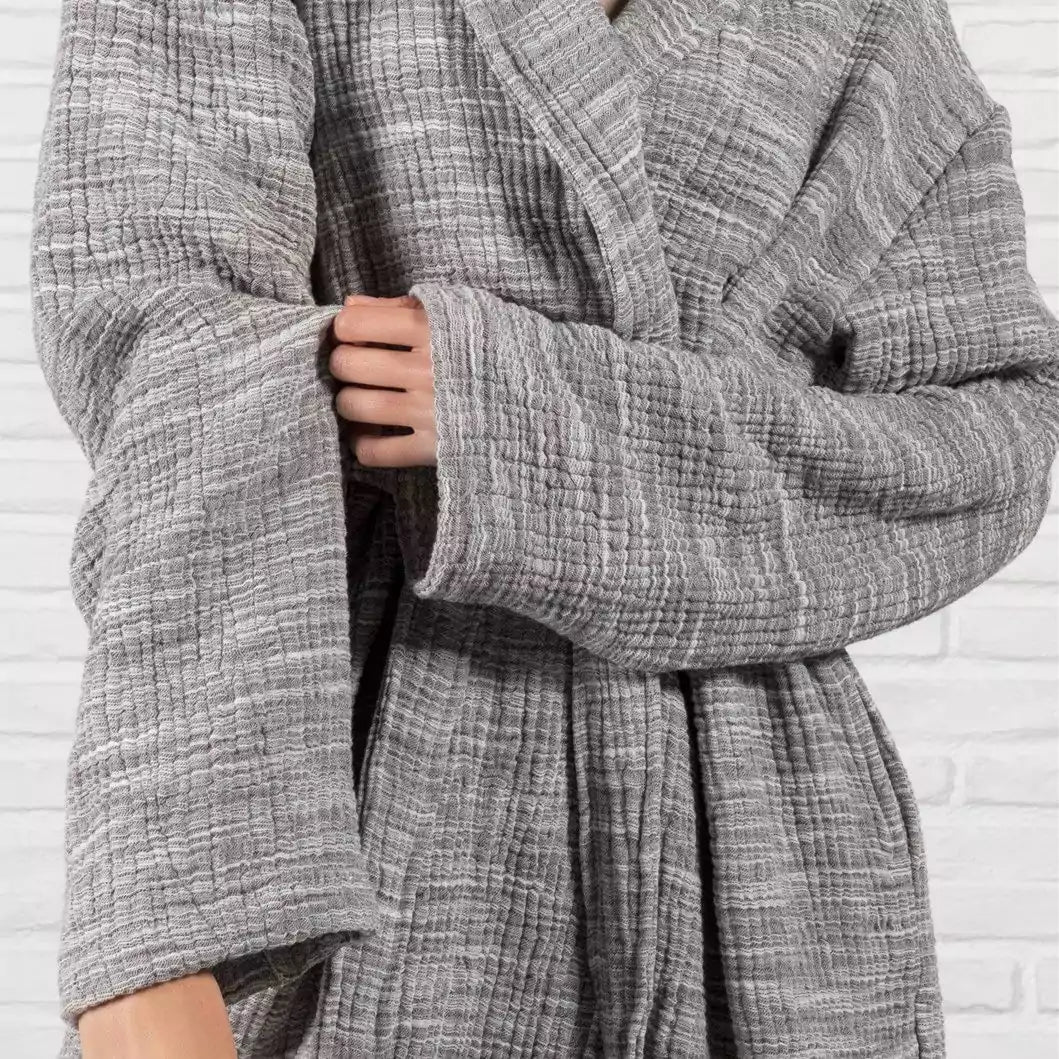Are you trying to decide between a classic robe or a stylish kimono robe for your next spa day, lounging at home, or even as a special gift? This guide will help you understand the differences and choose the perfect robe for any occasion, body type, and style preference.
Understanding the Key Differences Between Kimono and Classic Robes
When choosing between a kimono and a classic robe, understanding the key differences in design, fabric, and functionality can help you select the perfect style for your needs. Each offers its own unique charm, suited to different occasions and preferences, so let’s explore what sets them apart.
Traditional vs. Modern: How Culture Influences Robe Design
Kimono robes originate from Japan, where they were traditionally worn for ceremonial purposes. However, modern kimono robes have adapted to Western fashion, making them a stylish choice for casual wear and special events. Classic robes, on the other hand, are more structured and are typically associated with Western culture, characterized by their straightforward design and practicality.
Kimono robes usually have wide sleeves and a loose fit, which gives them a flowing, elegant appearance. Classic robes offer a more structured silhouette, ideal for those who prefer a more traditional and timeless look.
Materials and Textures: What to Look for in Each Style
When selecting between kimono and classic robes, the fabric plays a critical role in comfort and appearance. Classic robes are often made from absorbent materials such as cotton, terry cloth, or flannel, perfect for everyday use, especially after a shower. Kimono robes, however, are commonly made from silk or satin, giving them a luxurious and breathable feel.
-
Classic Robes: Typically made from durable materials like cotton or terry cloth, which are highly absorbent and perfect for post-shower lounging.

-
Kimono Robes: Often crafted from silk or satin, which are lightweight and breathable, making them ideal for warmer climates or special occasions.
The Comfort Factor: Which Style Feels Better for You?
Comfort is subjective, but if you're looking for something soft and absorbent for daily use, a classic robe made from cotton or flannel may be the right choice. If you're after something more stylish for warmer weather or an elegant event, a silk kimono robe offers both comfort and sophistication.
Choosing the Right Robe Based on Occasion
When selecting the perfect robe, the occasion plays a significant role in determining the right style and fabric. Whether you’re lounging at home, preparing for a spa day, or dressing for a special event, the robe you choose should match both the setting and your comfort needs. Let’s explore how to pick the ideal robe for every occasion.
Relaxation at Home: Casual Robe Styles for Daily Use
For daily lounging, practicality and comfort are key. Classic robes made from cotton or terry cloth provide warmth and are perfect for everyday wear. They are easy to wash and can be worn year-round, making them a go-to for many people.
-
Classic robes offer superior warmth, making them ideal for cool mornings or after-bath wear.
-
Kimono robes, while lighter and more stylish, may be better suited for warmer climates or light indoor lounging.

Spa Days or Special Treatments: Finding the Perfect Luxurious Robe
When visiting a spa or indulging in a special self-care day, your robe choice can enhance the experience. Kimono robes, especially those made from silk or satin, provide a lightweight and luxurious feel that adds to the spa-like atmosphere.
-
Silk or satin kimono robes are breathable, making them perfect for spa days.
-
For a cozier option, a plush classic robe made from velour or fleece can give a luxurious, comforting experience.
Weddings and Special Events: How to Make a Statement in a Robe
Kimono robes have become a popular choice for bridal parties and other special events due to their elegant design and ease of customization. Brides often choose silk or satin kimonos for their getting-ready photos, which make a beautiful keepsake for the big day.
-
Choose a silk or satin kimono robe for bridal events or special celebrations to add a touch of elegance.
-
While classic robes can also be used, they tend to have a more understated, traditional look that may not stand out as much in photos.
Seasonal Considerations: Light vs. Heavy Fabrics
Your robe choice may also depend on the season. Lightweight kimono robes are ideal for spring and summer, while heavier, classic robes made from fabrics like fleece or flannel are better suited for cooler months.
Style Preferences and Body Types
When it comes to choosing the perfect robe, your personal style and body type are important factors to consider. The right robe can enhance your figure and complement your fashion preferences, whether you favor a more structured look or a flowing, relaxed fit. Let’s take a closer look at how different robes suit various body types and style preferences.
Kimono Robes for Petite Figures: Accentuating Your Shape
Kimono robes, with their flowing sleeves and loose fit, work well for petite figures as they create a longer silhouette. For petite individuals, shorter kimono robes can be a flattering choice, ensuring the robe doesn’t overwhelm the frame.
Classic Robes for a Timeless, Elegant Look
Classic robes are great for those who prefer a structured and timeless look. The belt can cinch the waist, providing a flattering fit for various body types.
-
Classic robes with a belted waist accentuate curves, creating a fitted and elegant silhouette.
-
Longer classic robes can give tall figures a refined, sophisticated appearance.
The Influence of Color and Pattern on Robe Selection
Color and pattern can greatly influence the overall look and feel of a robe, making them key factors in your selection process. Whether you prefer bold, eye-catching designs or subtle, neutral tones, the right choice can enhance your style and reflect your personality. Let’s explore how different colors and patterns can impact your robe selection for any occasion.
Bold Colors for Vibrant Occasions
If you're looking to make a bold statement, opt for bright, vibrant colors, especially in kimono robes. These are often adorned with intricate patterns, making them stand out at special events or simply adding a splash of color to your wardrobe.
-
Bold red, royal blue, and deep green are popular choices for kimono robes when you want to make a statement.
Neutral Tones for Subtle Elegance
For a more subtle and elegant look, neutral tones like beige, soft pink, and gray are perfect for both kimono and classic robes. Neutral colors make the robe versatile, ideal for daily wear or understated luxury.
Robe Care and Longevity: Maintaining Your Kimono or Classic Robe
Proper care is essential for maintaining the quality and longevity of your kimono or classic robe. Different fabrics require different levels of attention, and following the right care routine can ensure that your robe stays soft, vibrant, and comfortable for years to come. Here’s how you can take care of your robe to keep it looking and feeling its best.
Proper Washing Techniques for Different Fabrics
To extend the lifespan of your robe, it’s important to follow the right washing instructions. Cotton and terry cloth robes are generally machine washable, while silk and satin kimono robes require more delicate care.
-
Classic Robes: Machine wash with mild detergent on a gentle cycle.
-
Kimono Robes: Hand wash or use a delicate cycle with cold water, avoiding harsh chemicals.
Tips for Storing Your Robe to Avoid Wear and Tear
Hang your robe on a padded hanger to avoid stretching the fabric. For kimono robes, avoid direct sunlight as it may cause the fabric to fade.
-
Store your robe in a cool, dry place, especially silk and satin robes to maintain their sheen.
Sustainability in Robe Fashion: Choosing Eco-Friendly Fabrics
As consumers become more conscious of their environmental impact, sustainability has become a key consideration in robe fashion. Opting for eco-friendly fabrics not only supports the environment but also offers comfort and durability. Whether you’re choosing organic cotton or bamboo, sustainable robes are both stylish and responsible. Let’s explore the best options for eco-conscious robe selection.
Organic Cotton, Bamboo, and More: Sustainable Options in Robes
If you’re eco-conscious, choosing robes made from sustainable materials such as organic cotton or bamboo is a great option. These fabrics are not only better for the environment but also feel incredibly soft and breathable.
-
Bamboo robes are naturally hypoallergenic and moisture-wicking, making them a great sustainable choice.
-
Organic cotton robes are gentle on the skin and are free from harmful pesticides.
The Benefits of Investing in High-Quality, Eco-Conscious Designs
Investing in eco-friendly robes means you’re supporting sustainable practices while also getting a product that is built to last. Sustainable fabrics like organic cotton and bamboo tend to be more durable, reducing the need for frequent replacements.


Share:
Can Blankets Cause Fever? The Truth About Blanket Materials and Your Health
Are Turkish Towels Better?